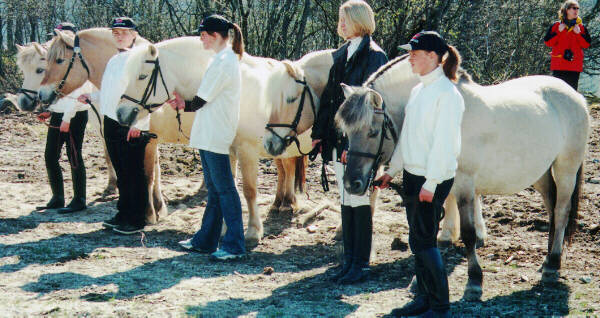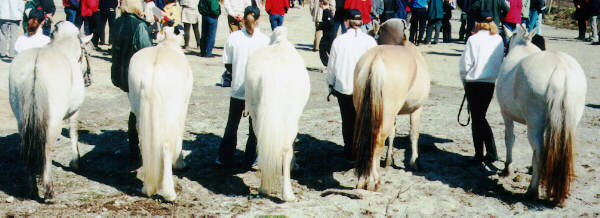The Norwegian Fjord Horse






The Norwegian Fjord Horse has probably been bred in geographic isolation for four thousand years or more, when it first migrated to Norway and was domesticated. Archaeological excavations of Viking burial sites demonstrate that Fjord Horses have been selectively bred for at least 2,000 years, when it they were used by the Vikings as war horses. It horse is now one of the national symbols of Norway!
The Norwegian Fjord Horse retains many characteristics of primitive European horses and bears a striking resemblance to the horses painted on cave walls by ice age artists some 30,000 years ago. They are extremely hardy, able to thrive on poor grazing and endure the harsh weather conditions of their environment, which can be hot and dry in the summer, and cold and wet in the winter. It is the breed that most closely resembles the Przewalski’s horse. This includes an upright mane (which may fall over if it grows long enough), along with primitive coloring and markings.
Originally the breed is known to have included bay and brown horses. Presumably chestnut and the cream dilute colors (palomino, buckskin etc.) also existed in the Norwegian Fjord Horse since the genes for these appear to be in the current day population.
At the end of 1800's the Norwegian Fjord Horse almost died out. Today’s horses all descend from a single surviving stallion, Njal 166, who was born 1891. In genetic terms he is known as a founder stallion: his genes have influenced the development of the entire breed and are carried by all living Norwegian Fjord Horses.
Because so few individuals survived the genetic diversity of the breed was much reduced, and some alleles were lost altogether, possibly including the AA and At alleles of the agouti locus. The breed went through what is called a genetic bottleneck. At the time of the bottleneck the wild-type allele at the dun locus seems to have been lost, so that now all Norwegian Fjord Horses are dun. In this breed the dun allele therefore is the only allele at the locus and is said to be fixed (i.e. its frequency is 100%). The colors of Norwegian Fjord horses are shown in the table below and discussed thereafter.
| Genotype at the agouti locus | genotype at the extension locus |
genotype at the cream locus |
phenotype |
color modified by dun gene |
| A+_ | E+_ |
C+C+ |
Brunblakk |
wild-type bay |
| AaAa | E+_ |
C+_ |
Gra |
black or smokey black |
| A+_ or AaAa | ee |
C+C+ |
Rodblakk |
chestnut |
| A+_ | E+_ |
CCrC+ |
Ulsblakk |
buckskin |
| A+_ or AaAa | ee |
CCrC+ |
Gul |
palomino |
| A+_ or AaAa | E+_ or ee |
CCrCCr |
Kvit |
perlino or cremello |

Upper photo, from left to right: uls dun, brunblakk dun, gulblakk dun, rødblakk dun and grå. Photo by Stefan Vorkoetter.
Photos courtesy of Bluebird Lane Fjords
website:
http://bluebirdlane.com
Lower photo, from left to right: grå, rødblakk dun, gulblakk dun, brunblakk dun and uls dun. Photo by Stefan Vorkoetter.

Brunblakk
Brunblakk is the most common color of Norwegian Fjord Horses and is the color of about 90% of all registered horses (2005). It may be the effect of dun on light (wild-type) bay as it is unsure whether the bay and brown agouti alleles exist in the breed. The body coat is pale yellow-brownish, but the shade varies from cream yellow to light brown. Paler colored horses have white manes while darker horses have darker manes. In Norwegian the darker stripe of hair in the middle of the mane is called the "midtstol", while the darker hair in the middle of the tail is the "halefjær". In brunblakk the dorsal stripe, midtstol and halefjær are black or dark brown.
Rødblakk
Rødblakk is the Norwegian Fjord Horse equivalent of red dun. The body color is a lighter or darker shade of pale yellowish red. In some cases, it can be difficult to tell the difference between a brown or a red dun. The midtstol, dorsal stripe and halefjær are reddish brown. They are always darker than the body color, but never black. The mane and tail vary from white to a pale yellowish color. Rødblakk foals may be born with white hooves, but these darken over time.
Grå
Although grå means gray grå dun horses are actually black dun horses, or occasionally smokey black dun (i.e. black with both cream and dun dilution). Grå is in no way a form of the conventional gray that causes graying over time. The bodies of grå horses are a lighter or darker shade of gray, from pale silver gray to dark slate gray. In grå horses the dorsal stripe, midtstol and halefjær are lighter than the main body, although the manes and tails are darker and can be almost black.
Ulsblakk
Ulsblakk is the Norwegian Fjord Horse equivalent of buckskin dun, where both the cream dilution and the dun dilution are present together. The body coat is cream, with a paler mane and tail. The midtstol", dorsal stripe and halefjær are gray or black. Originally ulsblakk was the predominant color of registered Fjord horses and was also called borket. It became less popular due to the production of kvit foals when ulsblakk horses were bred together.
gulblakk
Gulblakk is the Norwegian Fjord Horse equivalent of palomino dun and one of the rarest of the Fjord horse colours. The cream and dun dilution genes are present together, diluting a red base color. The body coat is cream. The mane and tail is paler than the body and may be white. The midtstol", dorsal stripe, halefjær and points are a darker (but still pale) golden color, but may be indistinct on paler horses.
Kvit
Kvit is the Norwegian Fjord Horse equivalent of cremello or perlino dun. It is an off-white with very faint cream or indistinct primitive markings. It is a rare color, and may not exist at present. This is due to there being intentional selection against this un-favoured color, which have glass (blue or wall) eyes. The color could be resurrected by crossing gulblakk with either ulsblakk or gulblakk, or by crossing two ulsblakk horses together.
Primitive Markings
The primitive markings of the Norwegian Fjord Horse include the distinct midsection in the forelock, mane (midtstol) and tail (halefjær), and the dorsal stripe. They may be dark in color, as in Brunblakk horses, or lighter than the coat color, as in grå horses. In very pale horses it may be difficult to distinguish these marks, with the back, mane, tail and forelock looking monochrome or nearly so.
Horizontal stripes may occur on the legs (zebra-stripes), being most prominent and numerous on the forelegs. These are the same color as the midtstol and the other markings, but are often of a paler shade. They tend to be more visible during the summer. Once again these may be indistinct or missing from pale horses. They may also be missing in grå horses, whose legs may be of the same color as the body, or darker up to the knees and hocks. Foals are born without zebra-stripes, which, if they are going to appear at all, do so after the first coat is shed.
Sometimes there are small brown spots on the body, for example on the thigh or cheek. Occasionally there may also be dark stripes across (at approximate right angles to) the withers.
White Markings
White markings are not common in Norwegian Fjord horses and, apart from a small white on the forehead, are considered undesirable. At 1982 meeting of Norges Fjordhestlag it was decided that stallions and colts with other white markings can’t be licensed.
Back to page on dun horses
|